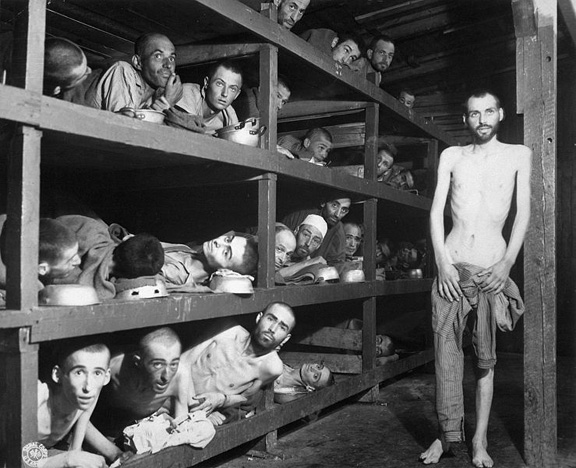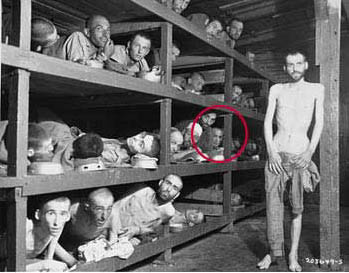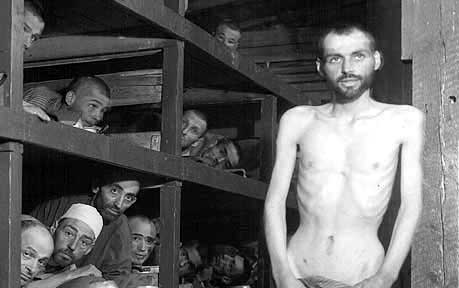Survivors of Buchenwald Concentration Camp The famous photo above was taken inside Buchenwald Barrack #56 by Private H. Miller of the Civil Affairs Branch of the U. S. Army Signal Corps on April 16, 1945, five days after the Buchenwald camp was liberated by the Sixth Armored Division of the US Third Army on April 11, 1945. This photo was published by the New York Times on May 6, 1945 with the caption "Crowded Bunks in the Prison Camp at Buchenwald." Block #56 was an adult barrack in the "Small Camp" at Buchenwald. For identification of the prisoners, see this photo on Flickr. Miklos Grüner (Nikolaus Gruner) has identified himself as the 16-year-old boy shown in the bottom left-hand corner of the photo above; although Grüner says he was suffering from tuberculosis and near death, he was not in the hospital barrack for TB patients. In May 1944, at the age of 15, Grüner was sent to Auschwitz-Birkenau where he was registered and then transferred to the Monowitz camp to work in the I.G. Farben factories. When Auschwitz-Birkenau was evacuated on January 18, 1945, Grüner was taken to Buchenwald. Elie Wiesel has identified himself as the prisoner at the end of the second tier of bunks from the bottom. His is the last full face that you see, encircled in red, to the left of a post in the photo below. Born on September 30, 1928, Elie was 15 and a half when he was sent on a transport from Hungary to Auschwitz-Birkenau in May 1944, and then transferred to Monowitz to work.  The photo below is a close-up of the right side of the photo above. The face of 16-year-old Elie Wiesel can be seen in the bottom row to the left of the post in the center of the photo.   The photo above shows a group of orphan boys walking out of the Buchenwald camp on April 27, 1945. In his book entitled "Night," Elie wrote that he became sick three days after the camp was liberated on April 11, 1945 and was in the hospital for two weeks. In a book entitled "The Children of Buchenwald" by Judith Hemmendinger and Robert Krell, there are the stories of 31 of the orphan boys at Buchenwald, including the story of Elie Wiesel in Chapter 11. On page 54 of the book is this footnote: Romek and Abram in Block 8 were unaware that Block 66 held the children at liberation. They thought themselves the only two children in Buchenwald. The authors also mention on page 113 that Block 66 was the barrack for the orphan boys at Buchenwald. On this web site, Jewish professor Ken Walzer is quoted as follows, regarding the orphans at Buchenwald: Among the older boys was Eliezer Wiesel from Sighet, Rumania, who was protected in block 66 with hundreds of others. According to a news article published in October 2008 on the Sun Times News Group web site, Paul Argiewicz has identified himself as the 16-year-old prisoner in the third tier of bunk beds, to the left of a post in the center of the photo shown below.  According to the Sun Times article, written by Wynn Koebel Foster, Argiewicz was one of only 300,000 survivors out of a population of 3,300,000 Polish Jews. Like Elie Wiesel, Argiewicz was a teenager who was brought from Auschwitz-Birkenau to Buchenwald when the camp closed in January 1945, and both were orphans in the Buchenwald "Small Camp." Argiewicz had lied about his age during the selection at Birkenau, claiming that he was 18 years old and experienced as an electrician so that he would be selected for work, when he was actually under 15 years of age and was destined to die in the gas chamber. Argiewicz told Foster of the Sun Times that he had the added advantage of being able to speak fluent German "with a Bavarian accent." (Germans in Bavaria speak a dialect called Bayerisch.) Shortly after the war ended, a traveling exhibit of huge photographs from the Nazi concentration camps, including Buchenwald, was first shown in St. Louis, MO and then taken to Washington, DC. The photograph below shows visitors looking at the most famous photo taken at Buchenwald.  ContinueBuchenwald OrphansOld photos of BuchenwaldCongressmen & ReportersEdward R. Murrow ReportLiberation ClaimsLiberation DayFirst liberators arriveGerman civilians tour BuchenwaldExhibits put up by prisonersMore exhibits at BuchenwaldBack to Buchenwald liberationHomeThis page was last updated on November 15, 2009 |